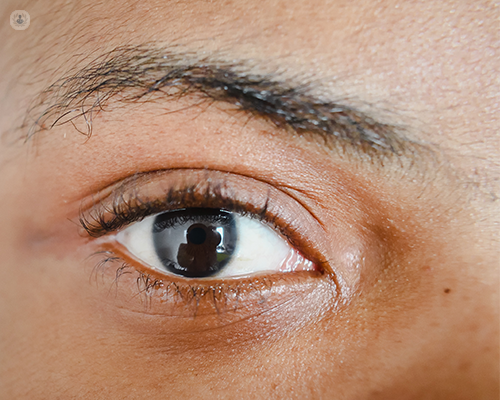How can thyroid eye disease be treated and stabilised?
Written by:The link between thyroid dysfunction and thyroid eye disease (TED) isn’t yet fully understood. However, there are numerous measures available to treat TED.
Miss Kimia Ziahosseini is a consultant ophthalmologist and oculoplastic surgeon who has spent many years diagnosing and managing thyroid eye disease. Learn from her about what TED is, its wide spectrum of symptoms and how TED is treated.

What is thyroid eye disease?
Thyroid eye disease (TED) usually affects patients who have thyroid gland dysfunction or had thyroid gland dysfunction in the past. However, about 10 per cent of patients with a dysfunction of the thyroid gland never develop TED.
Thyroid eye disease is an autoimmune disease: it’s a reaction between antibodies and some white blood cells (lymphocytes) to cells in the eye muscles, eye tissue and far in the eye socket (the orbit).
Thyroid eye disease is also known as:
- Graves’ ophthalmopathy
- Graves’ orbitopathy
- Thyroid ophthalmopathy
- Thyroid associated ophthalmopathy
What causes it?
We can’t yet fully understand the reasons for the link between under (or over) production of thyroid gland hormones and thyroid eye disease.
What are the mild symptoms of thyroid eye disease?
In most cases, patients with thyroid eye disease (TED) experience mild symptoms of dry eye and eye irritation. In fact, in some cases, symptoms are so mild that patients might not even be aware they have TED.
What are the severe symptoms of TED?
Patients who have significant inflammation of the eye due to TED might experience:
- Uncomfortable eyes
- Watery eyes
- Red eyes
- Puffy upper or lower eyelids
- A deep, “boring” constant ache of the eye socket
- A ‘staring’ appearance due to retraction of the upper eyelid, a bulging eye (proptosis), or both
- Double vision (diplopia) (‘ghosting’ of images, or pain on eye movements)
- Reduced colour perception (red colours appearing ‘greyish’)
- Blurring of vision
- Visual loss
This inflammatory period can last up to two years and can begin at any time. In some people, TED inflammation occurs before thyroid dysfunction is diagnosed and for other people, it occurs after the diagnosis of their thyroid dysfunction.
How is thyroid eye disease treated?
First and foremost, taking into account that TED is a result of thyroid dysfunction, treating the patient’s thyroid dysfunction is our first line of treatment. This alone often improves the eye condition. Then we can also reduce symptoms and treat TED through several lifestyle and medical measures.
What lifestyle adjustments are good for TED symptoms?
- Stop smoking: Quitting smoking as a lifestyle habit is one of the single most effective ways to improve the symptoms.
- Humidify the air: Mild symptoms such as eye discomfort and dryness can be improved by creating a less dry environment.
- Wear sunglasses: Wrap-around, polarizing sunglasses can help to reduce glare
- Use eye drops: Lubricant eye ointment at bedtime and artificial tears during the day will help to maintain moisture in the eye.
- Get an eye compress: Eyelid swelling can be reduced with cool compresses and by keeping your head raised while you sleep.
- Cover one eye: If you’re experiencing double vision, covering one eye will immediately relieve it — it doesn't matter which eye is covered. Double vision can also be improved with the use of Fresnel prisms (pronounced ‘frennel’) placed on spectacle lenses to help re-align both eyes.
What medical treatments are used to treat TED?
Your oculoplastic surgeon will discuss all aspects that are relevant to your condition. Furthermore, it’s helpful that you give us photographs from before your thyroid problem started.
Selenium
Recent evidence suggests that patients who take a 200 microgram supplement of selenium each day for six months during the active period of their inflammation achieve a greater improvement in the condition of their eyes. This is most likely due to underlying mild selenium deficiency.
Brazil nuts are an alternative source of selenium but patients should avoid consuming more than 4 Brazil nuts per day to avoid risking selenium overdose.
Immunosuppression
While the inflammatory period of TED is typically self-limiting and can be treated during its one to two-year phase, active orbital inflammation must be treated immediately to avoid debilitating long-term complications. These include:
- Eyelid retraction
- Double vision (diplopia)
- Proptosis (protrusion of the eyes)
- Loss of vision
Current treatments to manage active orbital inflammation include oral or intravenous steroids (or other immunosuppressive medicines such as Azathioprine), and low dose orbital radiotherapy, which is considered to reduce the need for (and therefore the risks of) systemic immunosuppressive treatment.
Oral Steroid therapy has a 65 per cent response rate and is effective in reducing soft tissue inflammation. They may be prescribed as tablets over a six to 12-week period. Steroid-related side effects are relatively common. These include:
- Weight gain
- Raised blood pressure
- Blood sugar elevation that can lead to or worsen diabetes
- An increased risk of osteoporosis and joint damage
- Sleep disturbance
- Mood changes and rapid mood swings e.g. feeling very happy one minute and very sad and weepy the next minute
Other methods of administering steroids are available to minimise the potential complications of oral steroid therapy. These include:
- Pulsed intravenous (IV) steroid injections (either repeated daily for three days or weekly).
- Local injections of steroid around the eye, known as periocular steroids.
Intravenous steroid therapy has an 85 per cent success rate. It involves weekly infusions of steroid for 6 to 12 weeks depending on the response.
Periocular steroids have been shown to be effective and are not likely to cause systemic side effects but can briefly cause the pressure in the eye to increase, requiring monitoring and possibly treatment.
Radiotherapy
Low-dose orbital radiotherapy may be used to suppress inflammation. It is usually given daily on an outpatient basis for two weeks (and used in combination with steroid therapy). Side effects of radiotherapy can include hair loss at the temples and a brief increase in soft tissue inflammation during treatment — this occurred in 14 per cent of cases in one study.
Radiotherapy is generally avoided in patients with diabetes, particularly if the retina has undergone diabetic changes. It’s also avoided in young people because of an increased risk of tumours developing in the future. However, to this day no such cases have been reported.
Surgery
If necessary, operations to treat bulging eyes (orbital decompression), double vision (squint surgery) and abnormal eyelid height or fullness, are usually performed once the disease has settled. Since orbital decompression surgery (to bring back the eye into the socket) can affect both double vision and the appearance of the eyelids, this surgery, when required, should be performed before eye muscle or eyelid surgery.
A very small amount of patients suffer from marked inflammation that threatens their sight and do not respond adequately to the treatments referred to above. In these patients, urgent orbital decompression intervention (within days or weeks) may be necessary to protect vision.
To learn more about orbital decompression surgery, see my other article: What to expect from orbital decompression surgery and recovery.
Learn how you can benefit from Miss Kimia Ziahosseini’s highly professional and personalised patient care – visit her profile.


